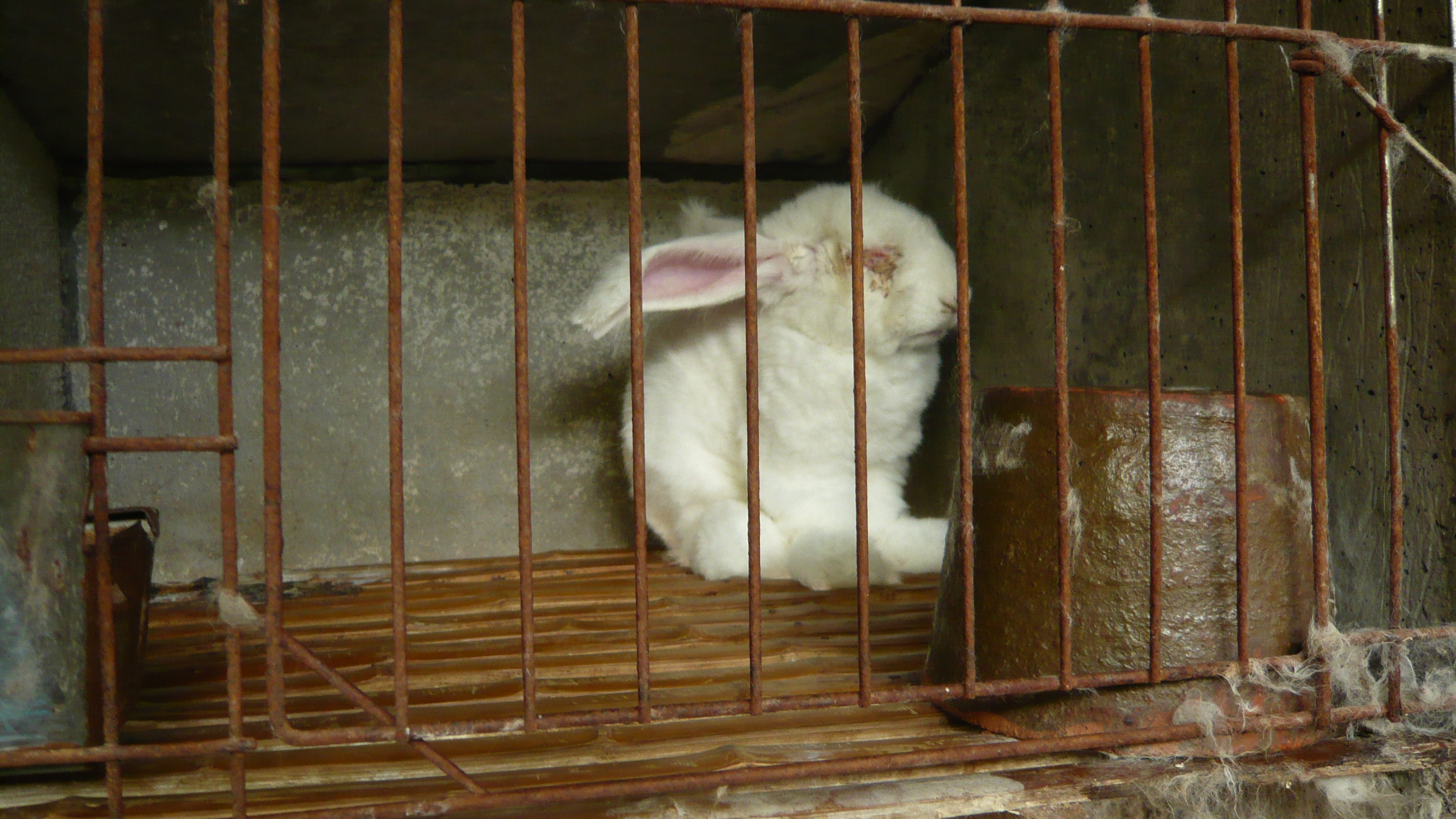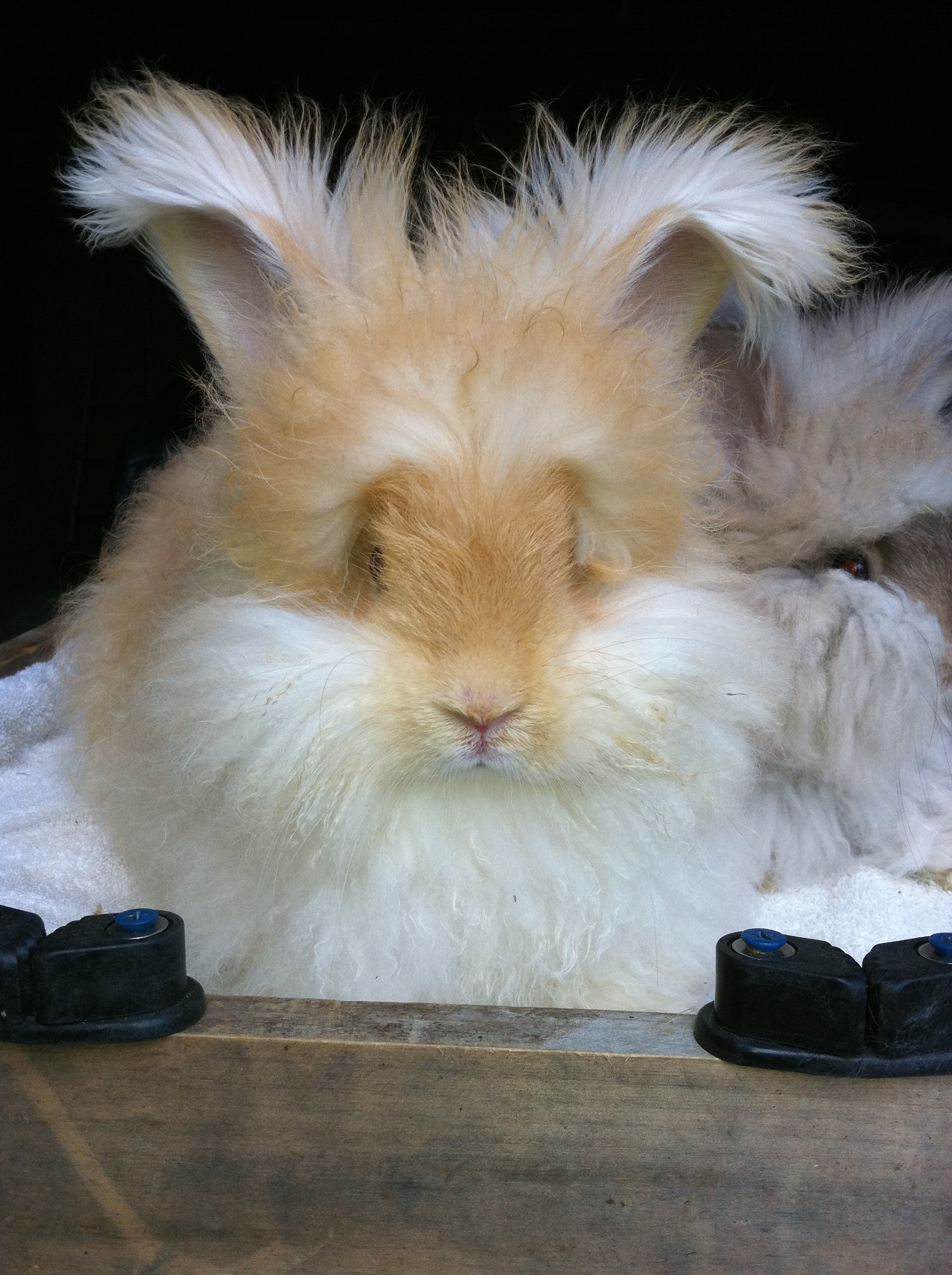
Featured Video - Angora
BBC World News discusses unethical treatment of Angora rabbits in the fashion industry's manufacturing stages.
The debate on the ethics and animal welfare of angora rabbits, and the resulting clothing made from it, has been raging in the media for sometime now. It started with a pretty horrifying video posted by PETA in mid November, of a Chinese angora farm and a terrified rabbit having its fur unceremoniously pulled out at the roots. The horrifying video of pinned down furry little bunnies screaming in pain as handfuls of fur is pulled out, leaving them bloody, naked and no doubt in an enormous amount of pain, was enough to sicken anyone, with the obvious exception of the Chinese angora farmers themselves. The video set in motion a shock waive of responses, with 268,274 views on YouTube to date. Posted directly before Christmas, when an angora sweater might seem like an ideal holiday gift, and in the spirit of goodwill to all men, presumably women and animals too, many retailers reacted by pulling their angora stock off shelves and promising not to purchase it in the future. At last count more than 35 major clothing retailers promised to stop buying angora, that included H&M, Calvin Klein, ASOS and Top Shop, while Zara and Gap, both temporarily stopped placing orders and kept selling, while they confirm their suppliers compliance.
 China is the world’s greatest producer of angora fur, and thereby operates the greatest number of angora farms, with ninety percent of angora originating from the continent. Not a country renowned for its animal rights, with no standards for regulation of animal welfare and no penalties. Not that the West is so much better when it comes to the treatment of animals in agri-business and animal farming. We’ve all seen the disgusting undercover videos of how pigs, cows, chickens and sheep are treated in factory farming, the diabolical treatment and disgusting conditions. Never the less, this is a story about angora rabbits and their highly valued fur, and most of that comes from China. The photos released by PETA of the rusted dirty cages the rabbits are kept in, their obvious traumatization from having their fur ripped out every three months, and the sad isolation of bloodied, shivering naked bunnies cowering in the corner of their filthy cages, bore out everyone’s worst fears. Rabbits; the animals of childhood fairy tales, and close cousin to the Easter Bunny, how could anyone treat them with such inhumanity?
China is the world’s greatest producer of angora fur, and thereby operates the greatest number of angora farms, with ninety percent of angora originating from the continent. Not a country renowned for its animal rights, with no standards for regulation of animal welfare and no penalties. Not that the West is so much better when it comes to the treatment of animals in agri-business and animal farming. We’ve all seen the disgusting undercover videos of how pigs, cows, chickens and sheep are treated in factory farming, the diabolical treatment and disgusting conditions. Never the less, this is a story about angora rabbits and their highly valued fur, and most of that comes from China. The photos released by PETA of the rusted dirty cages the rabbits are kept in, their obvious traumatization from having their fur ripped out every three months, and the sad isolation of bloodied, shivering naked bunnies cowering in the corner of their filthy cages, bore out everyone’s worst fears. Rabbits; the animals of childhood fairy tales, and close cousin to the Easter Bunny, how could anyone treat them with such inhumanity?
 The retail reaction to the obvious inhumane treatment of angora rabbits begs the question however, is this is the right response. There is no question this has to stop, but surely this is about more than the treatment of just angora rabbits, it’s about our respect of animals in farming in general. Don’t get me wrong, I’m not a PETA member, never have been, and don’t intend to be. I’m not vegetarian or vegan, although I was for many years. I do not however think that the planet and the animals on it are there purely to be put into service for our own comfort and well-being, and theirs be damned. I think there is a greater question of supplier responsibility here; an old ongoing argument, and the same one that revolves around workers rights, fair pay and safe working conditions. In a world where most manufacturers still say they cannot possibly know the entirely of their supply chain, and cannot be held responsible for what they pay for in services, is a tired old argument. One used time and again by those that are ultimately responsible. In reality, how can they not be held responsible to audit their own supply chain? How can they not be held responsible for those that they choose to hire for services? This is no different than holding a manufacturer responsible for the safety and well being of their workers. It is essentially the same argument. Know where your materials come from! Know what has been inflicted and upon whom to produce them at the price, and within the timeline that you demand. Take responsibility for those that you hire or contract, whether those are farmers, rabbits or sample hands! Ultimately, it is that simple. The answer is not to ban a product or a material, or a factory, but to ensure you only employ those working ethically in the first place, and support the efforts of those that are trying to. Lack of knowledge is no longer an excuse that works. In essence this is a simple argument, all be it with complex ramifications.
The retail reaction to the obvious inhumane treatment of angora rabbits begs the question however, is this is the right response. There is no question this has to stop, but surely this is about more than the treatment of just angora rabbits, it’s about our respect of animals in farming in general. Don’t get me wrong, I’m not a PETA member, never have been, and don’t intend to be. I’m not vegetarian or vegan, although I was for many years. I do not however think that the planet and the animals on it are there purely to be put into service for our own comfort and well-being, and theirs be damned. I think there is a greater question of supplier responsibility here; an old ongoing argument, and the same one that revolves around workers rights, fair pay and safe working conditions. In a world where most manufacturers still say they cannot possibly know the entirely of their supply chain, and cannot be held responsible for what they pay for in services, is a tired old argument. One used time and again by those that are ultimately responsible. In reality, how can they not be held responsible to audit their own supply chain? How can they not be held responsible for those that they choose to hire for services? This is no different than holding a manufacturer responsible for the safety and well being of their workers. It is essentially the same argument. Know where your materials come from! Know what has been inflicted and upon whom to produce them at the price, and within the timeline that you demand. Take responsibility for those that you hire or contract, whether those are farmers, rabbits or sample hands! Ultimately, it is that simple. The answer is not to ban a product or a material, or a factory, but to ensure you only employ those working ethically in the first place, and support the efforts of those that are trying to. Lack of knowledge is no longer an excuse that works. In essence this is a simple argument, all be it with complex ramifications.
The average garment circles the globe multiple times and goes though hundreds of hands from fiber to clothing. The efforts to get cheaper, faster clothing, has so complicated the textile supply chain, that it necessitates taking advantage of those less fortunate in their country of birth, those who have little choice but to take what work they can get, simply to put food on their plates and support the ones they love, and those without a voice of their own –the environment and the other living creatures on it. At the end of the day, the consumer has no idea how many carbon emissions their $15 jeans have racked up. What pollution the dye process elicited. What wastage of natural resources, primary of which is water, the growing, cleaning and finishing of the fiber caused. Under what condition the fabric was woven or knitted, and who made it, or how many angora rabbits were traumatized and condemned to live in miserable conditions, all so that the likes of Banana Republic can sell an angora sweater for $17.99. The truth is that we all have to realize that these prices can only be achieved through the unethical treatment of animals, through pollution and through unsafe and unfair working conditions.
So what are the alternatives? In the textile chain there are many now, a plentitude of fabrics and fibers made with a conscience; organic fibers, Fair Trade, recycled, ones produced while paying a living wage and treating workers fairly, ones dyed naturally, or those not with closed loop water systems that clean up the mess they made and never release it into the environment. The same is true of animal fibers, just as there are free range, grass fed and organic alternatives to factory farming, there are similar alternatives in animal fibers and materials; veggie tanned leather, non mulesing sheep’s wool, and humanely kept Angora rabbits. Ambika is just one example humanely kept and collected Angora fiber. Based in the Catskills, she produces a line of hand crocheted clothing and accessories from her own Angora rabbits. Rabbits that do not have their fur ripped unceremoniously from the roots, but gently brushed during their natural molting season, while sitting on her lap. According to Ambika Conroy “I just [can’t] understand why we [have] to torture and kill all these sweet animals, when we could make an equally warm and luxurious product humanely “
We’re a long way from making transparency in the clothing supply chain mainstream, but there is an unprecedented level of awareness, a body of committed, caring activistic agencies set to make an example of anyone found wantonly flouting ethics, ecology and fair trade. But what of the animals used in the production of our clothing? It seems to me, they are new frontier of activism and ethics, the mainstreaming of which allows for such massive engagement, that dozens of major high street brands react instantly to the airing of a single video. And so it should be, we just have to ensure that we are not cleaning up one mess only to make another, and that the changes being made are long term and sustainable, not reactionary designed simply to avoid bad press.
Ambika Video: http://youtu.be/jAOaMuubua4
Ambika website: http://ambikaboutique.com/